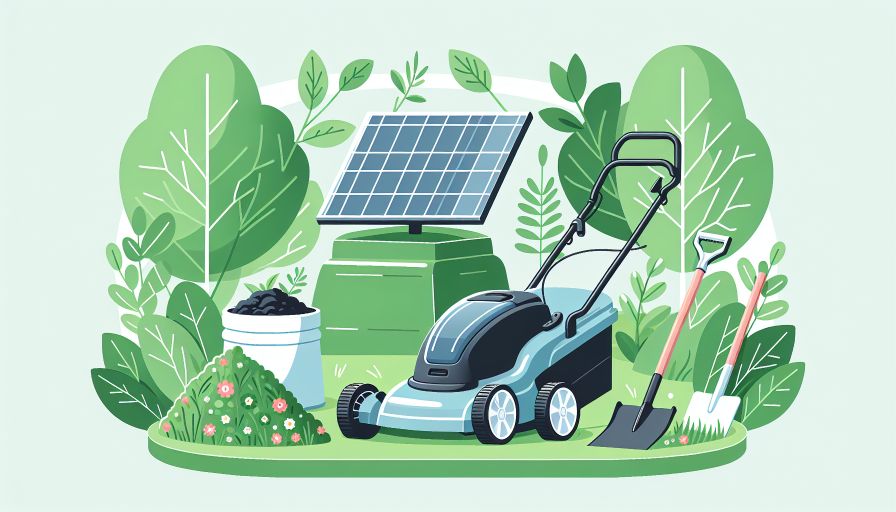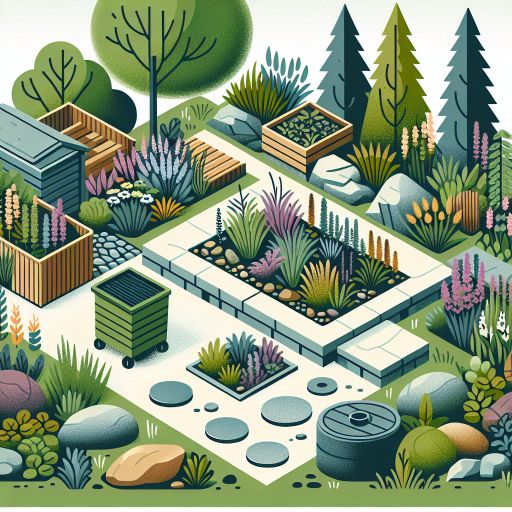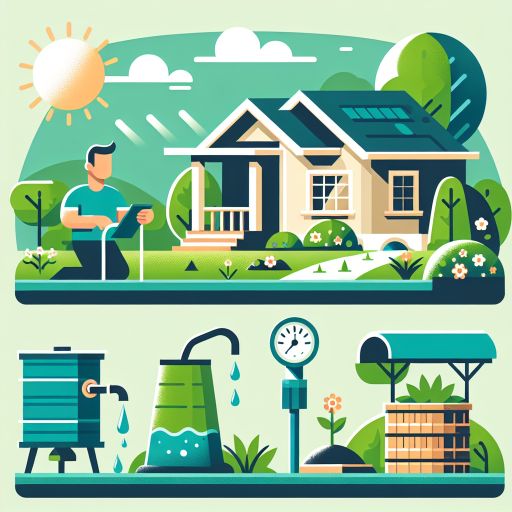
- Introduction to Sustainable Lawncare Practices
- Understanding the Environmental Impact of Traditional Lawncare
- Selecting Eco-Friendly Landscaping Materials and Plants
- Water Conservation Techniques for Lawns
- Organic and Chemical-Free Fertilization Methods
- Pest and Weed Management Through Sustainable Practices
- The Future of Sustainable Lawncare: Innovations and Trends
Introduction to Sustainable Lawncare Practices
Sustainable lawncare practices refer to methods and techniques aimed at maintaining lawns in an environmentally friendly manner. These practices focus on reducing the negative impacts on the environment commonly associated with traditional lawncare. The approach includes the use of eco-friendly materials, efficient water usage, natural fertilization, and pest management techniques that do not harm ecosystems.
The concept of sustainability in lawncare is part of a broader movement toward ecological stewardship and conservation. Sustainable lawncare practices ensure that lawns contribute positively to the environment by enhancing biodiversity, improving soil health, and reducing pollution. They address the need to maintain aesthetically pleasing green spaces without compromising the health of our planet.
Practitioners of sustainable lawncare often prioritize native plants, which are better adapted to local conditions and require fewer resources to thrive. They also employ water-saving technologies such as drip irrigation and rainwater harvesting systems. Additionally, they favor organic fertilizers over synthetic ones and adopt integrated pest management (IPM) strategies to control pests and weeds naturally.
Adopting sustainable lawncare practices can lead to numerous benefits. It helps in conserving water, reducing the use of harmful chemicals, enhancing soil structure, promoting wildlife habitats, and minimizing greenhouse gas emissions. Such practices also support the creation of healthier, more resilient lawns that can withstand environmental stresses better than conventionally managed lawns.
Overall, the shift towards sustainable lawncare is driven by a growing awareness of the environmental challenges posed by traditional lawncare methods and a commitment to adopting practices that contribute to the long-term health of our environment. It represents a responsible approach to lawn management, aligning with global sustainability goals.
Understanding the Environmental Impact of Traditional Lawncare
Traditional lawncare practices have long been associated with a range of environmental issues. Understanding the full scope of their impact is essential for fostering a shift towards more sustainable methods. These impacts can be categorized into several primary areas: pesticide and fertilizer runoff, excessive water usage, greenhouse gas emissions, and loss of biodiversity.
One of the critical issues with traditional lawncare is the use of chemical pesticides and fertilizers. These substances, while effective for promoting lush, green lawns, often have detrimental effects on the environment. Runoff from lawns treated with these chemicals can contaminate local waterways, posing risks to aquatic life and contributing to broader water quality issues such as algal blooms. According to the United States Environmental Protection Agency (EPA), urban runoff is one of the leading causes of water pollution in the country.
Furthermore, traditional lawncare typically involves substantial water consumption. Lawns are among the most irrigated crops in the United States, with the EPA estimating that up to 9 billion gallons of water per day are used for landscape irrigation. This high water demand can put a strain on local water supplies, particularly in arid regions or during periods of drought. Overwatering can also lead to soil erosion and nutrient leaching, further impacting the environment.
Greenhouse gas emissions are another significant issue. The use of gasoline-powered lawn mowers and other equipment contributes to air pollution and the release of carbon dioxide (CO2). The California Air Resources Board (CARB) reports that small engines, such as those used in lawn and garden equipment, produce a substantial amount of air pollutants, including volatile organic compounds (VOCs) and nitrogen oxides (NOx), which contribute to ground-level ozone formation and climate change.
Traditional lawncare practices also frequently lead to a reduction in local biodiversity. A monoculture lawn of non-native grass species can displace native plants and disrupt local ecosystems. This loss of plant diversity can have cascading effects on local wildlife, including insects, birds, and other animals that depend on native flora for food and habitat.
Given these environmental impacts, it is clear that sustainable lawncare practices are not only beneficial but necessary for mitigating the negative effects associated with traditional methods. By reducing chemical use, conserving water, lowering emissions, and promoting biodiversity, sustainable practices offer a pathway to healthier and more resilient landscapes.
Selecting Eco-Friendly Landscaping Materials and Plants
One of the most effective ways to promote sustainable lawncare is through the careful selection of eco-friendly landscaping materials and plants. Traditional landscaping often relies on non-native plant species and materials that can be detrimental to local ecosystems. In contrast, choosing the right materials and flora can significantly reduce the environmental impact associated with maintaining a lawn.
Native plants are an excellent choice for eco-friendly landscaping. They are naturally adapted to the local climate and soil conditions, which means they typically require less water, fertilizer, and pesticides compared to non-native species. This reduces the need for additional resources and minimizes negative environmental impacts. According to the U.S. Environmental Protection Agency (EPA), native plants also provide critical habitats for pollinators and other wildlife, supporting biodiversity.
Another key consideration is the use of sustainable materials for hardscaping elements, such as walkways, patios, and retaining walls. Opting for permeable paving materials can help manage water runoff and reduce erosion. Materials like recycled concrete, reclaimed wood, and natural stone not only minimize environmental footprint but also add unique aesthetic elements to the landscape design.
Composting and mulch are other significant components of eco-friendly landscaping. Using organic mulch can help retain soil moisture, reduce weed growth, and add essential nutrients back into the soil as it decomposes. The EPA recommends sourcing mulch from arborist wood chips or local composting programs to ensure it is free from harmful chemicals.
Incorporating drought-resistant plants can also contribute to sustainable lawncare practices. Xeriscaping, for instance, is a landscaping technique that focuses on using plants that require minimal water. This method can significantly lower water consumption and is particularly beneficial in regions experiencing water scarcity. Plants such as lavender, succulents, and native grasses are often used in xeriscaping projects for their resilience and low maintenance requirements.
Implementing rain gardens is another strategy to mitigate environmental impacts. Rain gardens are designed to capture and filter stormwater runoff, allowing it to replenish groundwater rather than flowing into storm drains and carrying pollutants to water bodies. The University of Minnesota Extension highlights that rain gardens planted with deep-rooted native plants can effectively reduce runoff and improve water quality.
When selecting plants, it is also essential to avoid invasive species. Invasive plants can outcompete native species, leading to a loss of biodiversity and disruption of local ecosystems. The National Invasive Species Council provides resources and lists of invasive plants to help gardeners and landscapers make informed choices.
In summary, choosing eco-friendly landscaping materials and plants involves prioritizing native species, using sustainable construction materials, employing organic composting and mulching practices, selecting drought-resistant plants, and avoiding invasive species. By making these informed choices, homeowners and landscapers can create beautiful, functional spaces while reducing their overall environmental footprint.
Water Conservation Techniques for Lawns
Water conservation is a critical component of sustainable lawncare. Implementing efficient irrigation techniques and utilizing drought-resistant plants can significantly reduce water usage while maintaining a healthy and vibrant lawn.
Irrigation Systems: Modern irrigation systems offer various options that can optimize water usage. Drip irrigation systems, for example, deliver water directly to the roots of plants, reducing evaporation and runoff. Sprinkler systems with adjustable heads and smart controllers that adapt to weather conditions can also be highly effective in conserving water.
A study conducted by the United States Environmental Protection Agency (EPA) found that upgrading to WaterSense labeled irrigation controllers could save an average home nearly 8,800 gallons of water annually.
Drought-Resistant Plants: Choosing drought-resistant or native plants can drastically cut down on the need for supplemental watering. Many native grasses and groundcovers are adapted to local climate conditions and can survive with minimal irrigation.
Below is a table of some drought-resistant grasses and their water needs:
| Grass Type | Water Needs (inches per month) |
|---|---|
| Bermudagrass | 1-1.25 |
| Buffalograss | 0.5-1 |
| Zoysia Grass | 1-1.25 |
| Fine Fescue | 1-1.5 |
Lawn Care Practices: Proper lawn maintenance can also contribute to water conservation. Mowing grass at a higher height allows for deeper root development, which can make the lawn more drought-resistant. Mulching grass clippings can help retain soil moisture and reduce the need for additional watering.
Regularly checking and maintaining your irrigation system can prevent leaks and ensure that water is being applied efficiently. According to the EPA, a broken sprinkler head can waste as much as 25,000 gallons of water over a six-month irrigation season.
Lastly, consider conducting a soil test to determine the moisture retention capacity of your lawn. Soils that are rich in organic matter have better water-holding capacity, reducing the need for frequent watering. Amending soil with compost can improve its structure and enhance its ability to retain moisture.
Implementing these water conservation techniques not only contributes to a sustainable lawn but also helps in reducing the environmental impact by conserving a vital resource.
Organic and Chemical-Free Fertilization Methods
Organic and chemical-free fertilization methods play a crucial role in sustainable lawncare, minimizing harmful environmental impacts while promoting healthy soil and robust plant growth. Traditional synthetic fertilizers, often rich in nitrogen, phosphorous, and potassium, can contribute to water pollution through runoff, leading to issues such as algal blooms and waterway eutrophication. Organic alternatives, however, offer a sustainable solution by enhancing soil health and reducing negative ecological footprints.
Organic fertilizers are derived from natural sources, including plant or animal matter, and are less likely to cause nutrient leaching. Common organic fertilizers include compost, manure, bone meal, and fish emulsion. These amendments not only provide essential nutrients but also improve soil structure, water retention, and microbial activity.
Here’s a comparison of the nutrient content in common organic fertilizers:
| Fertilizer Type | Nutrient Content (N-P-K) |
|---|---|
| Compost | 1-1-1 |
| Manure | 1-0.5-0.5 |
| Bone Meal | 3-15-0 |
| Fish Emulsion | 5-2-2 |
Another benefit of using organic fertilizers is the gradual release of nutrients. This slow-release mechanism helps in maintaining steady growth and reduces the risk of over-fertilization, which can lead to nutrient burn and plant stress. Moreover, organic fertilizers stimulate beneficial soil organisms, such as earthworms and mycorrhizal fungi, which play a pivotal role in nutrient cycling and soil health.
To implement organic fertilization effectively, it is essential to assess the specific nutrient needs of the lawn. Soil testing can provide valuable insights into nutrient deficiencies and guide the application of appropriate organic amendments. Additionally, incorporating organic matter regularly can enhance the long-term fertility and resilience of the lawn ecosystem.
In conclusion, transitioning to organic and chemical-free fertilization methods offers numerous environmental and agronomic benefits. By opting for natural fertilizers, homeowners and landscapers can foster healthy, sustainable lawns while mitigating ecological impacts.
Pest and Weed Management Through Sustainable Practices
Sustainable lawncare practices for pest and weed management focus on reducing harmful chemicals and embracing eco-friendly alternatives. By understanding the ecological balance within a lawn ecosystem, it is possible to manage pests and weeds effectively while minimizing environmental impact.
One of the key sustainable practices is integrated pest management (IPM). IPM combines different management approaches to control pest populations at acceptable levels. These methods include biological control, cultural practices, mechanical and physical controls, and chemical interventions, used as last resort. IPM emphasizes prevention and monitoring to minimize pesticide use.
Several methods can be employed under IPM to manage pests sustainably:
- Biological control: Introducing natural predators or parasites, such as ladybugs for aphid control or nematodes for grubs, helps maintain pest populations at manageable levels.
- Cultural practices: Maintaining healthy soil and promoting plant diversity creates an inhospitable environment for pests. Practices such as crop rotation, selecting pest-resistant plant varieties, and proper mowing height contribute to a robust lawn.
- Mechanical and physical controls: Mowing regularly, using barriers like row covers, and manually removing weeds or pests prevent infestations without harming the environment.
For weed management, organic mulching serves as an effective strategy. Mulching reduces weed growth by blocking sunlight, retains soil moisture, and enriches the soil as it decomposes. Organic mulches include grass clippings, wood chips, straw, and leaves.
Manual weeding is another low-impact method to control weeds. Regularly pulling weeds by hand, especially before they seed, can significantly reduce their presence. Tools such as weed pullers and hoes make this task easier and more efficient.
For large or persistent weed problems, herbicidal soap and organic herbicides derived from natural ingredients, such as vinegar or corn gluten meal, offer safer alternatives to synthetic chemicals. These products can suppress weed growth without leaving long-lasting residues in the soil.
Monitoring is an essential component of sustainable pest and weed management. Regular lawn inspections help detect issues early, allowing for timely interventions. This proactive approach reduces the need for extensive chemical applications and enables more targeted, effective treatments.
Finally, fostering a healthy lawn ecosystem is fundamental to sustainable pest and weed management. Practices such as proper aeration, overseeding, and maintaining soil health through composting enhance the lawn’s resilience. A biologically diverse lawn can better compete with weeds and resist pest infestations naturally.
The Future of Sustainable Lawncare: Innovations and Trends
The future of sustainable lawncare is being shaped by a variety of innovative techniques and emerging trends that promise to further reduce environmental impacts while maintaining aesthetically pleasing landscapes.
Technological Advancements
Technological progress is ushering in more efficient and environmentally friendly lawncare practices. One notable advancement is the proliferation of robotic lawn mowers. These autonomous devices reduce emissions by using electric power instead of gasoline. They also contribute to healthier lawns by cutting grass more frequently and finely, which can improve turf quality and reduce the need for supplemental fertilizers.
Another significant innovation is the use of smart irrigation systems. These systems utilize weather forecasts, soil sensors, and real-time data to optimize watering schedules, drastically reducing water waste. For example, companies like Rachio and RainMachine have developed controllers that can be adjusted via smartphone apps, offering more precise control over irrigation practices.
Plant Breeding and Genetic Modification
Plant scientists and horticulturists are working on developing drought-resistant and low-maintenance grass varieties. These grasses require less water, fertilizer, and mowing, thereby minimizing their environmental footprint. Varieties such as Bermuda grass (Cynodon dactylon) and Zoysia grass (Zoysia spp.) are being refined to enhance their resilience to various stressors, including drought and pest infestations.
Integrated Pest Management (IPM)
The adoption of Integrated Pest Management (IPM) continues to gain momentum in sustainable lawncare. IPM emphasizes the use of biological controls, such as beneficial insects and microbial agents, to manage pest populations. This approach minimizes reliance on chemical pesticides, reducing potential harm to non-target species and the surrounding environment.
Urban Lawn Alternatives
In response to the growing awareness of the environmental drawbacks of traditional lawns, there is an increasing interest in alternative landscaping solutions. This includes xeriscaping, which utilizes drought-tolerant plants and reduces water consumption significantly. Another trend is the replacement of turfgrass with clover or native plant species, which can offer ecological benefits such as improved biodiversity and soil health.
Community and Policy Initiatives
Community-driven initiatives and policy measures are also playing a critical role in promoting sustainable lawncare practices. Several municipalities have introduced rebate programs for residents who convert their lawns to more sustainable alternatives. Additionally, some governments are implementing regulations that limit the use of water and chemicals on residential lawns, further encouraging the adoption of sustainable practices.
As these innovations and trends continue to evolve, they hold the promise of making lawncare more sustainable and environmentally friendly, ensuring that green spaces can be enjoyed by future generations without compromising the health of our ecosystems.



